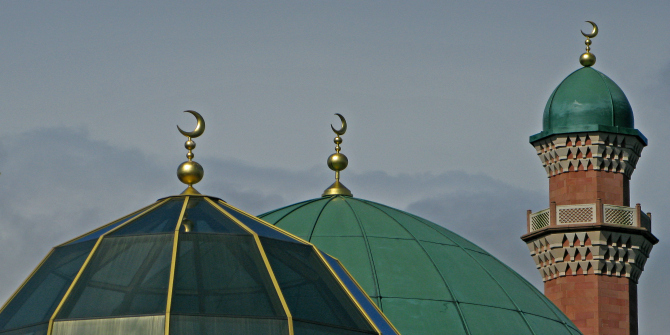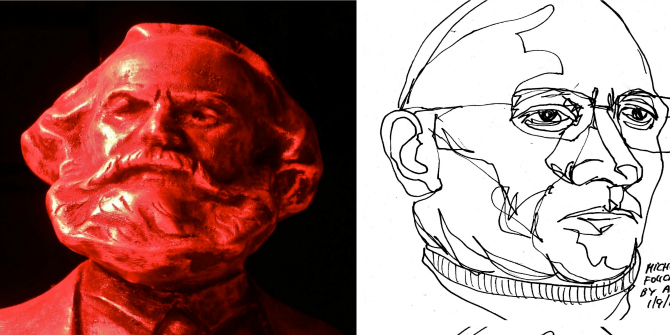 Reclaiming Beauty is a title bringing together authors from architecture, political science, and the wider social sciences, to discuss the central role of beauty in life and the academy. Sarah Burton explores three of the essays here, concluding that with thoughtful reading, the collection will reward the reader with original concepts and novel links.
Reclaiming Beauty is a title bringing together authors from architecture, political science, and the wider social sciences, to discuss the central role of beauty in life and the academy. Sarah Burton explores three of the essays here, concluding that with thoughtful reading, the collection will reward the reader with original concepts and novel links.

Reclaiming Beauty: Collected Essays in Political Anthropology: Volume I. Agnes Horvath and James B. Cuffe. Ficino Press. May 2012.
Reclaiming Beauty: Collected Essays in Political Anthropology, edited by Agnes Horvath and James B. Cuffe, seeks to “restore beauty to its rightful, arguably central place, not just in art and aesthetics, but for individual and social life in general” (p. 3). Through a range of interdisciplinary approaches to the concept of beauty, the collection works to reposition beauty as something not objective, but rather experiential and relational. One of the main strengths of the collection is this diverse assortment of authors which encompasses literary, historical, philosophical, political and sociological perspectives.
Cuffe’s chapter, ‘Beauty and Careful Representation: Interpreting the Social and the Cosmic’, is redolent of this interdisciplinarity. Cuffe cautions against what he sees as the current ‘progressivism’ mode of scholarship in which we assume that we are working toward something, and instead proposes that we view beauty not as something fixed but as “that which is revealed by our relation to it” (p. 151). Beauty, it seems, is not oppostionally relegated to subjective over objective but is found in our simple, daily immersedness in the social, the universe and the reciprocity therein. Cuffe proposes a more interpretative relationship with beauty as “necessary for ‘positive’ social change” (p. 164) and presents a modification of Vygotsky’s zone of proximal development as a way of interpreting beauty for social change. Terming it a “zone of interpretative development”, the intention is for it to enable the transmission of “an experience to those who do not hold the same lived experience but come to recognize an understanding of it” (p. 164). His stance of privileging “contemplation of one’s own relation to self, to others” in a state of “constant interpretative development” (p. 170) is certainly positive and the idea of using beauty as a means of careful representation of self and the world is intriguing. I’d question, though, his refutation of progressivism in light of his argument that beauty can lead to positive social change – surely this in itself is progress and teleological? The ideas, though fascinating, appeared not sufficiently fleshed out – as if too much was attempted in too short a space. The result of this is concepts which do not cohesively link to one another and given the tantalizing ideas within, this is unfortunate.
Conversely, Meredith Eliassen’s chapter, ‘Columbia’s Beauty: The Aesthetics of Nationalism in a New America’, has a distinct narrative. Eliassen details how Columbia, Samuel Johnson’s symbolic female personification of the American colony, became representative not only of physical grace but moreover of the virtues of female industry and agency that were necessary in both building and distinguishing America from its former British rule. Eliassen analyzes the instructional fairy tales given to young girls which emphasized the gaining of a beautiful exterior by performing beautiful – i.e. ‘good’ – actions. By comparing this with frontier literature and the crucial part played by women as “builders of the nation’s moral foundations” (p. 188) as well as the privileging of George Washington in the new nation’s psyche as an example of industrious beauty, Eliassen shows clearly how the desirable quality of beauty was used to national advantage in order to compel women to act differently to their British counterparts in terms of labour given. The argument, though compelling, suffers from its presumption that for all British women marriage meant retiring from work and public life. Certainly this may be true of middle and upper class women but it would be difficult to conceive of non-industrious, labour-active working class married women in the eighteenth century. Equally the notion of the fairy tale as pedagogical is not new (cf. Marina Warner and Jack Zipes) and young girls were frequently cautioned against being too aware of physical over moral beauty. But with fairy tales largely consigned to the domestic sphere of the nursery, the notion of them as part of nation-building shows an original edge.
Philip Ruch’s chapter, ‘Beauty in the Political Sciences: The Insufficiency of Contemporary Accounts and the Premature Death of a Category’, questions the lack of inclusion of beauty as a category of political science. Noting that a fundamental claim of modern science is to “see the world, especially human life, as it is” (p. 215), Ruch argues that beauty is as significant to political science as categories such as sexuality, power, death, in that they all exist as objects “outside of a person” (p. 215). The chapter begins with the claim that “the descriptions of lower motives of human nature fills libraries” (p. 215) and that beauty, as their opposing category, has been excluded. Ruch seems to bear this exclusion heavily and spends much of the chapter castigating the social sciences for “concealing” the need for beauty (p. 221), going so far as to suggest that one day a “smart psychologist” will conceptualize the desire for beauty as a disease and predicts “the day people will feel ashamed of their need for beauty” (p. 221). Whilst broadly accepting Ruch’s contestation of existing categories such as power and liberty as unstable or intangible, I find it difficult to view them as therefore analogous to the unstable concept of beauty. When he writes that “beauty overwhelms, floods and affects” (p. 220) this seems indicative of an emotional rather than scientific response; it lacks evidence and the ability to be measured or tested which consequently seems to justify its lack of categorical inclusion in political science.
As a collection, Reclaiming Beauty contains moments of genuine significance, brought about by the juxtaposition of seemingly disparate disciplines. These almost clashing perspectives actively prompt the reader to question the place of beauty in the social. However, there are some omissions. Ideas from Ruskin and Baudrillard dominate the text yet neither are explicitly acknowledged, and this is representative of the book as a whole, where arguments risk being overly abstract and lack references throughout. This made the book a frustrating read at times, in that contributors make unsupported claims regarding their ideas. Passionately communicated run-on sentences featuring confused syntax dominate – almost to the point of the book appearing to replicate the spontaneous thoughts or utterances of the authors. Though featuring enormously interesting ideas these are difficult to engage with owing to the tendency towards lacking a rigorous substantive argument which the reader can clearly follow. With thoughtful, painstaking reading the collection will reward a reader with original concepts and novel links – you just have to work that bit harder. A worthwhile read for anyone interested in the ties between beauty, gender, and the wider social sciences.
——————————————————————————————-
Sarah Burton is currently an ESRC-funded doctoral candidate at Goldsmiths College. Her research uses the concept of mess to investigate the value system(s) underpinning the production of knowledge in contemporary social theory. Having also spent several years involved in various artistic projects centring round theatre, classical music and writing/publishing, her academic research draws both on her formal education and also these forms of creative practice. Sarah convenes the British Sociological Association Postgraduate Forum and Activism in Sociology Forum, of which she is a founding member. Sarah also does lots of ‘fringe’ academia and is part of the collective working on the Woman Theory project. Read more reviews by Sarah.







